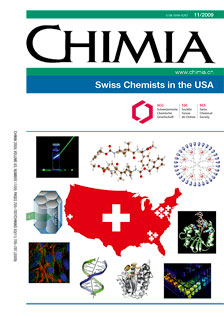Polynuclear Photocatalysts in Nanoporous Silica for Artificial Photosynthesis
DOI:
https://doi.org/10.2533/chimia.2009.721Keywords:
Artificial photosynthesis, Carbon dioxide reduction, Metal-to-metal charge-transfer, Nanoporous silica, Water oxidationAbstract
In this article, recent progress towards robust photocatalysts for the visible light-driven reduction of CO2 by H2O is presented. All-inorganic polynuclear photocatalysts consisting of an oxo-bridged binuclear charge-transfer chromophore (metal-to-metal charge-transfer) coupled to a multi-electron transfer catalyst anchored in a nanoporous silica scaffold have been developed. Mild synthetic methods afford assembly, on silica nanopore surfaces, of heterobinuclear units with donor and acceptor metal centers selected for optimum solar coverage and photon to chemical energy conversion efficiency. A photocatalyst featuring a TiOCrIII group coupled to an IrO2 nanocluster on MCM-41 silica support is shown to function as an efficient visible light water oxidation unit. Nanostructured Co3O4 clusters in mesoporous silica SBA-15 constitute the first example of a nanometer-sized multi-electron catalyst made of an earth-abundant metal oxide that evolves oxygen from water efficiently. For carbon dioxide reduction, a binuclear unit consisting of a Zr acceptor and a CuI donor (ZrOCuI) acts as light absorber as well as redox site, splitting CO2 to CO and H2O upon excitation of the charge-transfer transition. Structural and mechanistic insights of the photocatalytic units based on static and time-resolved optical, FT-infrared, FT-Raman, EPR, X-ray absorption spectroscopy and transmission electron microscopy are critical for improving designs. The photocatalytic units presented here form the basis for developing robust and efficient artificial photosynthetic systems for the conversion of carbon dioxide and water to a liquid fuel.Downloads
Published
2009-11-27
Issue
Section
Scientific Articles
License
Copyright (c) 2009 Swiss Chemical Society

This work is licensed under a Creative Commons Attribution-NonCommercial 4.0 International License.
How to Cite
[1]
Chimia 2009, 63, 721, DOI: 10.2533/chimia.2009.721.







